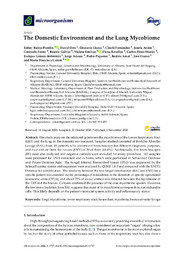Please use this identifier to cite or link to this item:
https://hdl.handle.net/11000/37779Full metadata record
| DC Field | Value | Language |
|---|---|---|
| dc.contributor.author | Rubio-Portillo, Esther | - |
| dc.contributor.author | Orts, David | - |
| dc.contributor.author | Llorca, Eleuterio | - |
| dc.contributor.author | Fernández Aracil, Cleofé | - |
| dc.contributor.author | Anton, Josefa | - |
| dc.contributor.author | Ferrer, Consuelo | - |
| dc.contributor.author | Gálvez, Beatriz | - |
| dc.contributor.author | Esteban Ronda, Violeta | - |
| dc.contributor.author | Revelles, Elena | - |
| dc.contributor.author | Pérez-Martín, Carlos | - |
| dc.contributor.author | Gómez Imbernón, Enrique | - |
| dc.contributor.author | Adsuar, Jorge | - |
| dc.contributor.author | Piqueras, Pedro | - |
| dc.contributor.author | Amat, Beatriz | - |
| dc.contributor.author | Franco, José | - |
| dc.contributor.author | Colom Valiente, María Francisca | - |
| dc.contributor.other | Departamentos de la UMH::Producción Vegetal y Microbiología | es_ES |
| dc.date.accessioned | 2025-11-03T11:36:02Z | - |
| dc.date.available | 2025-11-03T11:36:02Z | - |
| dc.date.created | 2020 | - |
| dc.identifier.citation | Microorganisms. 2020 Nov 2;8(11):1717 | es_ES |
| dc.identifier.issn | 2076-2607 | - |
| dc.identifier.uri | https://hdl.handle.net/11000/37779 | - |
| dc.description.abstract | This study analyzes the relationship between the mycobiome of the Lower Respiratory Tract (LRT) and the fungi in the domestic environment. Samples studied consisted of Broncho-Alveolar Lavage (BAL) from 45 patients who underwent bronchoscopy for di erent diagnostic purposes, and dust and air from the houses (ENV) of 20 of them (44.4%). Additionally, five bronchoscopes (BS) were also analyzed and negative controls were included for every procedure. All samples were processed for DNA extraction and cultures, which were performed in Sabouraud Dextrose and Potato Dextrose Agar. The fungal Internal Transcribed Spacer (ITS2) was sequenced by the Solexa/Illumina system and sequences were analyzed by QIIME 1.8.0 and compared with the UNITE Database for identification. The similarity between the two fungal communities (BAL and ENV) for a specific patient was assessed via the percentage of coincidence in the detection of specific operational taxonomic units (OTUs), and about 75% of co-occurrence was detected between the mycobiome of the LRT and the houses. Cultures confirmed the presence of the core mycobiome species. However, the low rate of isolation from BAL suggests that most of its mycobiome corresponds to non-culturable cells. This likely depends on the patient’s immune system activity and inflammatory status. | es_ES |
| dc.format | application/pdf | es_ES |
| dc.format.extent | 20 | es_ES |
| dc.language.iso | eng | es_ES |
| dc.publisher | MDPI | es_ES |
| dc.rights | info:eu-repo/semantics/openAccess | es_ES |
| dc.rights | Attribution-NonCommercial-NoDerivatives 4.0 Internacional | * |
| dc.rights.uri | http://creativecommons.org/licenses/by-nc-nd/4.0/ | * |
| dc.subject | fungi | es_ES |
| dc.subject | mycobiome | es_ES |
| dc.subject | lower respiratory tract | es_ES |
| dc.subject | house dust | es_ES |
| dc.subject | mycobiota | es_ES |
| dc.subject | bronco-alveolar lavage | es_ES |
| dc.title | The Domestic Environment and the Lung Mycobiome | es_ES |
| dc.type | info:eu-repo/semantics/article | es_ES |
| dc.relation.publisherversion | https://doi.org/10.3390/microorganisms8111717 | es_ES |

View/Open:
The Domestic Environment and the Lung Mycobiome.pdf
2,84 MB
Adobe PDF
Share:
.png)
